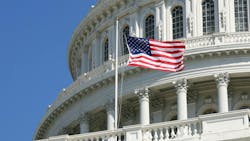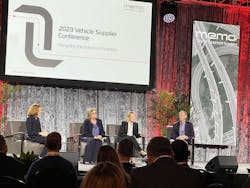NOVI, Michigan—Emission-conscious government regulations are steadily making their way through the pipelines of local, state, and federal agencies. These regulations will force consumers and fleets to pivot from less fuel-efficient and diesel-burning engines. But the further OEMs progress in their EV endeavors and as competition between China heats up, industry executives speculate whether those regulatory targets are attainable and what it will take to get there.
See also: Is the EV boom turning into a bust?
At the Motor and Equipment Manufacturers Association's annual conference, Julie Fream, MEMA president and CEO, moderated a panel on regulations and emissions featuring Dan Nicholson, VP of strategic technology initiatives at General Motors, Sandy Stojkovski, CEO NA, Vitesco Technologies, and Ann Wilson, SVP government affairs at MEMA. The conversation focused on pain points in the industry in reaching 50% EVs in the U.S. by 2030.
"Look at the regulations themselves, they certainly drive us there," Stojkovski said. "But there's a lot of things that have to go right with the consumers and with the infrastructure."
To gauge a realistic expectation of EV adoption in the year 2030 requires looking at consumers because "they're the ones that buy the vehicles," Nicholson said.
"What we're already seeing is more manufacturers, more availability because a lot of people customers want to buy EVs, but what they won't do is compromise on the segment that they want to buy," Nicholson said. "If they want a pickup truck, they want a pickup truck, and they're not going to buy an EV just to buy an EV."
As this is true for consumers, this is also true for fleet owners—but it's less about wants and more about needs. A Tesla cannot haul what a diesel-powered truck can haul, and a Ford Lightning doesn't have the range necessary for a full day's worth of work that some fleets require.
With EVs, there is still a long way to go.
See also: 'So here we are': Truckers debate a post-gas-tax future
Regulations and resources
When customers think about an electric vehicle, they may think of range, capabilities, and charging infrastructure. But with the OEMs designing the vehicles, they also have to consider current regulations and requirements and how those regulations could change.
The U.S. Environmental Protection Agency and the U.S. Department of Transportation currently have regulations that OEMs are "working off of," Wilson said.
But those regulations have yet to be finalized, although Wilson said the goal is to have them final by the end of the year. Once those regulations are final, they will drive EV sales and U.S. content. Wilson explained that those purchasing EVs made with U.S.-sourced materials will receive more significant tax incentives.
But another question that must be asked is if the U.S. can even provide those resources.
Not only can the U.S. not produce batteries and other EV parts as quickly and cheaply as China, but it also lacks the labor—and the capital—required to do so.
"The 2030 model year is only five and a half years away," Nicholson said. "And, you know what the product life cycles look like. You also know probably how long it takes to build battery cell plants. You know that's a two-year construction project, followed by a ramp-up, et cetera, et cetera."
See also: Congressman calls Stoughton Trailers an 'inspiring example' in China trade war
Once the factories and facilities are built, companies must weigh what's more economical regarding factory workers or R&D engineers.
"We look very carefully at what is the highest priority application of our labor resources for R&D as well as, of course, our scarce capital," Stojkovski said. "In many cases, you can't find the labor that is necessary for your factories. ... And at the same time, there is very limited legal immigration available, and so, I really see this is a necessary next step of ensuring that we're able to get the talent in all different areas that we need legally in this country as a basis for the all the work that has to be done."
Before those factories can be staffed or built, they must first have permit approval from the government.
"Permitting reform is something that's absolutely critical because we've got to acknowledge the fact that we're behind on batteries—in terms of refining capacity, refining the metals—that (China) got to lead on, and we've got to build that back up," Nicholson stated. "The permitting takes so long, whether we're talking about a mining activity or refining activity. We really want to hit these time frames. That has got to be handled."
Further, utilities nationwide aren't held to federal standards on supplying electricity to EV fleets or consumers. A fleet owner in California might use services from a utility eager and ready to provide charging solutions for the fleet; however, a fleet in rural West Virginia might not have an electricity supplier ready or able to offer charging solutions.
"Our consumers, depending on where they live, are looking at a very different situation with regard to pricing of electricity, readiness of the grid, and reliability of the grid—which is critical," Nicholson said.
Regulations and vehicle design
Regulations also greatly influence how OEMs design their vehicles. Above all, OEMs must remain compliant with federal regulations. Both Nicholson and Wilson highlighted some issues with regulations, however.
"One thing that's really, really important is the harmonization of those standards across the different agencies that have a hand here," Nicholson said. "It used to be relatively simple: EPA took care of criteria emissions and made sure that the air was clean to breathe and free from smog. And CAFE, under NHTSA, took care of fuel economy and made sure that we had energy independence. … But now that EPA is also regulating greenhouse gases, which is, in essence fuel economy, these are overlapping sets of rules, and they're not harmonized.
"These details matter a lot because OEMs don't have a choice not to comply," Nicholson said. "We need to have compliant plans, and in order to do that, we've got to have these things harmonized so the same set of vehicles that we sell can actually pass the EPA's regulations and the CAFE regulations for NHTSA. We need it harmonized, and we need it harmonized now."
The shift from internal combustion engines to EVs is an enormous undertaking, and it will take time, government action, billion-dollar investments, and trial and error to fully realize.
"Look at the massive transformation that has to happen of essentially removing all the deployed capital associated with combustion activities and replacing it with electric drive technologies," Stojkovski said.
Wilson would like to see changes in government regulations that emphasize not only electric vehicles but also other alternative powertrain and fuel sources.
"There are large parts of the heavy vehicle industry where battery electric is just not going to make sense in the near term," Wilson said. "So, you need to look at light weighting, hydrogen. Are there other ways that we can help improve fuel economy, lower emissions, but not necessarily making all battery electric?
See also: Hydrogen vs. BEVs: The road to energy independence
"The question really gets to be: Is our federal government going to be thinking broad enough to allow these technologies and then also allow the system that can change over time as we see what the demands are," Wilson said.
What an election could bring
With a large amount of the EV shift relying on government regulations and funding, Fream asked the panel what it would mean if a different party entered the White House after next year's election.
"This administration needs to finalize these regulations, the EPA and the DOT and NHTSA regulations," Wilson said, "and harmonize them all for the first quarter of next year because there's what's called the Congressional Review Act, which lets Congress throw out regulations in 60 days if they don't like them. So that's absolutely essential."
For heavy-duty trucking fleets and stakeholders, expect to see regulations finalize next month. Light vehicle regulations are anticipated to finalize early in 2024, Wilson said.
There is, however, the possibility of a new president taking office and making quite a few changes. Wilson said she often hears from folks in the industry that regulatory certainty is a must to continue moving forward. But because of the regulations already set in place on the federal and state level, Wilson doesn't expect to see a significant shift from the EV pushback to ICE vehicles.
About the Author
Jade Brasher
Senior Editor Jade Brasher has covered vocational trucking and fleets since 2018. A graduate of The University of Alabama with a degree in journalism, Jade enjoys telling stories about the people behind the wheel and the intricate processes of the ever-evolving trucking industry.


